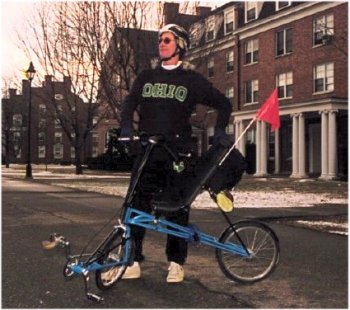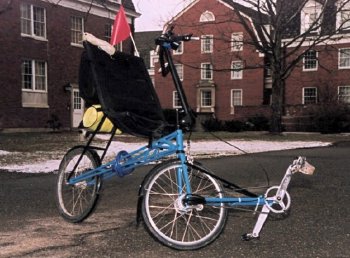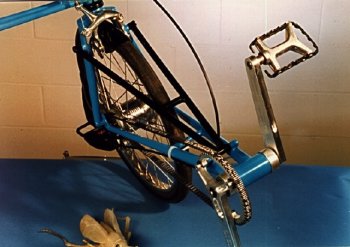| Issy's "Grasshopper" | |
| In 1996, Issy Urieli sent Brian Wilson photos of his bike Grasshopper and
he scanned them in.
It's a small, front wheel drive recumbent bike with a mesh seat.
This is Izzy and the bike. |
 |
 |
This is a shot showing only the bike. |
| This is a close up of the drive system. |
 |
From: Izzy Urieli
<urieli@bobcat.ent.ohiou.edu>
The ride is wonderful - absolutely quiet and oil-free. I suppose that there is some loss in efficiency, just based on the feel when you try to freewheel the pedals, but I cannot quantify it, and in my commuting mode I find it perfectly satisfactory. I am geared very low to combat the very hilly area in Athens, Ohio. izzi "chirp-chirp-chirp" urieli, a_hupper
Date: Wed, 27 Mar 1996 10:17:12 EST From: Issy Urieli Subject: [hpv] Hands off riding with FWD? Hi, I have been riding a FWD with pedals on the forks for a few years now, and I must take issue with Sean Costin's comment. My latest Grasshopper has about 72 degrees head angle - nevertheless I can start from stop (uphill if need be) no handed and with very little steer. Certainly while riding with powerfull strokes I can stay on a very reasonable straight line. It is only a matter of getting used to the seemingly impossible combination of steering, pedalling, and maintaining balance - all with ones feet. It takes at least a year to become as natural with this system as with the conventional one, but its worth it I agree with Sean that the arm crank should be attached to the steerer tube for both arm and leg cranking. I do like to have my arms on the steering arm, in spite of the fact that I only really use them occasionally. Good luck - it sounds like an interesting worthwhile project. I would love to try the system out when you build it. izzi "hands are for peeling bananas" urieli, hupper
From: tschmidt@mus.ch (Theo Schmidt) Date: Wed, 27 Mar 1996 11:12:46 +0100 Subject: [hpv] belt drives Toothed Belts: I have been using toothed belts everywhere I could, because they work so well and don't require lubrication. I use a type called HTD (High Torque Drive) made by Continental, which use round teeth and can apparently handle greater forces than the old.fashioned trapez-tooth design. These come in metric sizes with 3, 5, 8, and 14 mm pitches. I use the 3 and 5mm sizes. The 3mm size is really thin and flexible, so you usually need a wide belt (25mm) to transmit human-type torques (the limiting factor is always the small tooth-wheel). The 5mm size is more robust and I use the 5mm size where width and cost is a factor, as then a 15mm wide belt is usually sufficient. I am not certain which is more efficient, the wide thin belt or the narrow thicker belt. The Continental belts are made of rubber with a Kevlar or somesuch tension member. Other makes use a polyurethane/steel combination. The small tooth-wheels are easily made oneself by buying a length of aluminium profile with the required number of teeth and parting/turning down on a lathe. The biggest job is attaching or even making the flanges, which are necessary. The large tooth-wheels are also easily made from plywood and attached to pedal cranks. They don't always require teeth or flanges. If teeth are required, they are easily made by waxing the belt, applying runny epoxy putty to the disc, and wrapping the belt around, thus casting the teeth in two stages. If you do this, you have to get the diameter just right. Or use two discs of different diameters, one is the disc, the other the flange, and insert a few nails as occasional teeth. I have used such drives extensively on boats (advantage no rust) and hybrid vehicles (advantage no oil) and they work well if you design more or less by the book (available from the manufacturers) and get the tension right. CVT Belts I used to drive a DAF 33 car, which had two independent CVT belt drives for each rear wheel. This was better for traction than either a differential or a locked differential. Also you couldn't get stuck if a belt parted, not that this ever happened to me. I later had a DAF 46, which unfortunately had a single belt and diff. Both these cars were really easy to drive and had very good mileage (under 5 liters gasoline per 100 km). The belts were controlled by a kind of mechanical analog computer consisting of centrifugal weights, springs, and vacuum cylinders with valving. I think this system was ideal for cars and it is unfortunate that the power-mad public didn't take to such vehicles, forcing DAF to discontinue making cars. I believe they still make trucks, but withoout CVTs. I think the system is probably just a bit too inefficient for an HPV application, mainly at the extreme ratios which would be required. I have seen the Conrad CVT unit: this is a tiny high speed device of no use at all except with high speed motors. Theo Schmidt
|
|